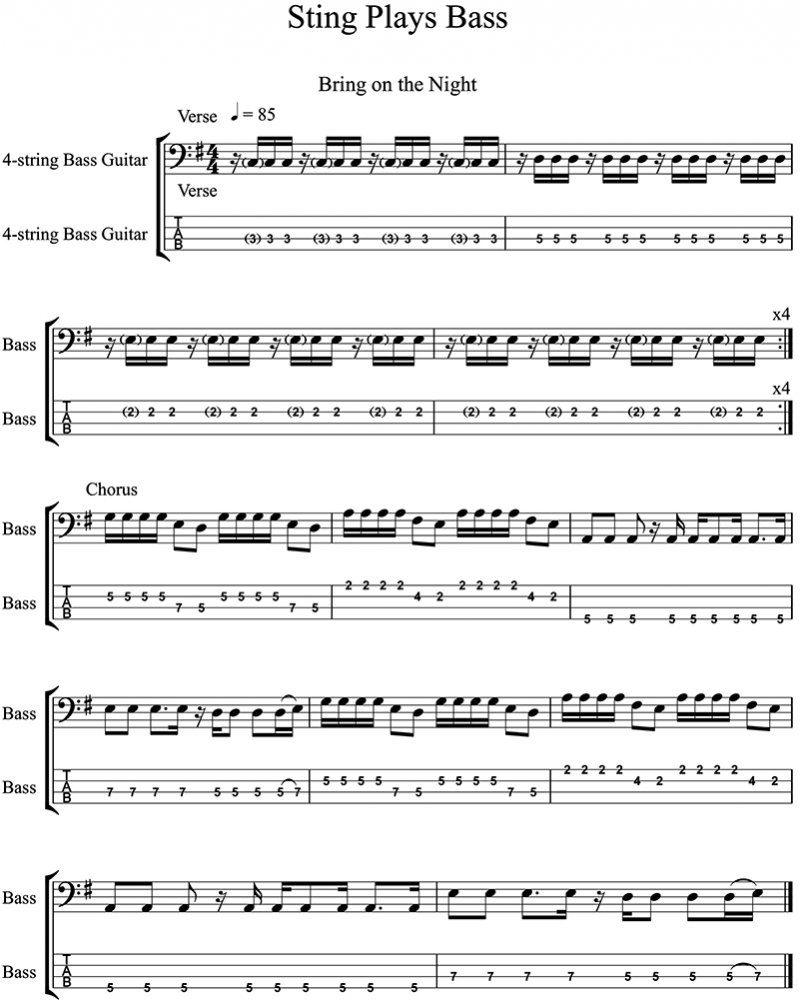Deep Thinking: Sting Plays Bass
Deep Thinking: Sting Plays Bass
I’ve always been an admirer of Sting ’s songwriting and singing (especially while playing some very tricky bass lines). However, I often feel that his bass playing is overlooked because of his other talents. For me, he constructs lines that are made to make the song sound and feel better rather than make them vehicles to show off his bass chops. Other examples of players doing this are Macca, John Deacon (Queen) and the late Dee Murray (Elton John). I’ve chosen two songs that demonstrate this, although I should add that there are many, many more!
The first example is Bring on the Night initially released on ‘Reggatta de Blanc’ (1979) but continually played by Sting as a solo artist in the years after The Police.
The basic verse groove is a reggae feel that was common to many Police songs in their early days and it is repeated four times. I have bracketed the semiquaver after the downbeat rests in some of the verse as the recording sounds as if he is accenting the second half of each beat’s final two semiquavers and thus adding to the reggae feel with guitarist, Andy Summers. The chorus is more rock based and, at times, quite funky. It is constructed from our old friend, the pentatonic scale.
The second example is the main verse riff from Walking on the Moon from the same album.
Space prevents me from adding the second part of the verse but the entire song has an implied shuffle pattern. Sting initially leaves a great deal of space for Summers and drummer, Stuart Copeland, although the bass line becomes more elaborate in the second part of the verse, which is almost a chorus. It is worth considering how Sting’s right–hand technique has changed over the years.
When he recorded ‘Regatta de Blanc’, he was using a pick yet nowadays he prefers to play almost exclusively with his right–hand thumb. He once favoured fretless Ibanez and Fender Precision basses so his intonation while singing is to be commended, not many rock basses did that in those days. Nowadays he mainly uses a battered 1954 (I think!) Precision that was made when Fender moved away from the slab cut bodies of the original Precisions and when Fender started to contour the bodies to make them more comfortable. The modern Precision design was introduced around 1955. His main amplifier each time I see him is an Ampeg SVT with an 8×10 cabinet. Also, in a Police performance in Paris that is on YouTube, he is using pedal boards to provide notes that fatten out the sound of the band.
Dr. Rob Burns is an Associate Professor in Music at the University of Otago in Dunedin. As a former professional studio bassist in the UK, he performed and recorded with David Gilmour, Pete Townsend, Jerry Donahue, Isaac Hayes, Sam and Dave, James Burton, Ian Paice and Jon Lord, Eric Burdon and members of Abba. He played on the soundtracks on many UK television shows, such as Red Dwarf, Mr. Bean, Blackadder, Not the Nine O’Clock News, and Alas Smith and Jones. Rob is currently a member of Dunedin bands Subject2change and The Verlaines.

